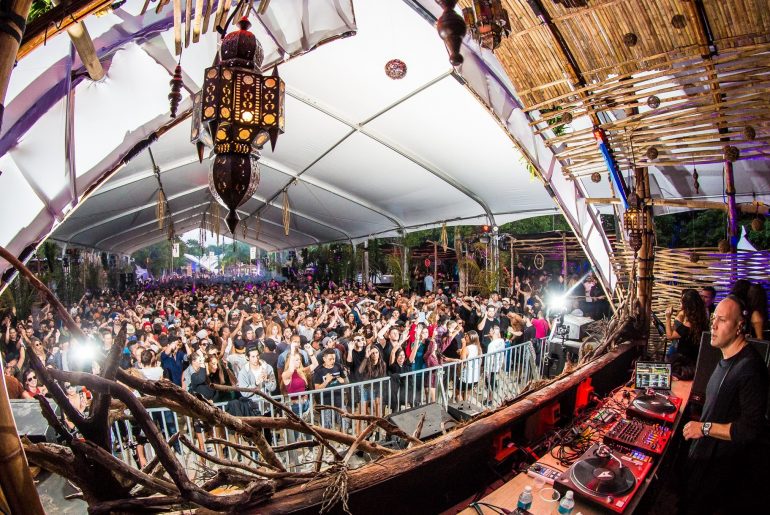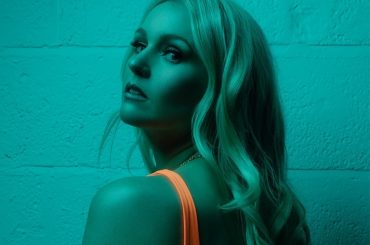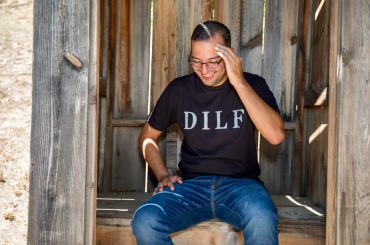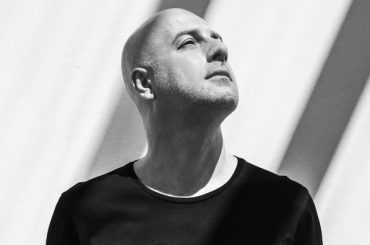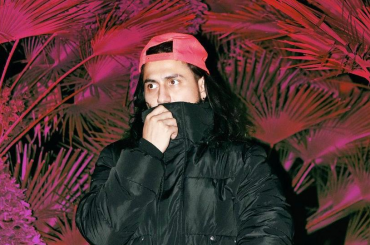
In some artistic circles, topping oneself isn’t really a challenge anymore. Case in point: Montreal’s DJ A-Trak.
Why? By the time he was old enough to vote, A-Trak (aka Alain Macklovitch) had won more international championships than Sugar Ray Robinson. Indeed, between 1997 and 2000, A-Trak took eight different DJ titles, including the 1997 DMC World Championship at the precocious age of 15, making him the organization’s youngest winner.
Lucky for us, A-Trak didn’t pack it in and head to Old Orchard Beach for the remainder of his days. No, he continued to pursue his art and push its boundaries. He created battle/breaks records. He contributed to a music-notation system for turntablists. Eventually, he hooked up with one of the world’s most important hip-hop artists, Kanye West, and since 2004 he’s been his onstage DJ. Heading into Kanye’s latest tour, A-Trak is all of 24-years old.
Perhaps true to his curious nature, A-Trak is not a Luddite DJ, one who refuses to turn a technological corner. He’s a battle-tested champ in old-school style, but he’s adopted Rane’s Serato Scratch Live, which allows DJs to access thousands of digital files, while still scratching up a storm. He’s even begun to incorporate Ableton Live software for choice performances. Surely, some in the scratch-jock world might view these developments with player-hater derision, but in A-Trak’s mind, there’s no such thing as heresy in the DJ world. Use the technology, he seems to say, as long as it suits your needs—DJ forums be damned.
We caught up with A-Trak, whose exploits had taken him to the other side of the International Date Line. Temporarily stationed in Sydney, Australia, A-Trak was with Kanye West in the middle of a continental tour opening for U2. So, how’s this, haters? A-Trak’s playing soccer stadiums with the most critically acclaimed hip-hop artist in the last five years and opening for the very biggest rock band in the world.
Free your mind, haters, and your ass might follow.
DJ Times: What inspired you to DJ?
A-Trak: I started off just scratching, trying to figure out how to make those mysterious noises with my dad’s turntable. I had seen scratching to rap videos just like any other kid. But I started figuring stuff out pretty quick, so I stuck to it.
DJ Times: Was there a DJ that you looked up to? If so, who was it and why were you inspired?
A-Trak: There wasn’t one person in particular that I looked up to at first. My brother had some friends who were DJs, and I used to listen to albums by Jazzy Jeff, Premier and Pete Rock to hear scratching. You have to understand that I was 13, so whatever I could get my hands on was gold. Then I met some other DJs from Montreal—guys who were older and more experienced—and they put me on to DMC videos with guys like QBert, Roc Raida, etc.
DJ Times: How long were you spinning before you kinda knew you were really good? What did you pattern yourself after?
A-Trak: Well, I won my first battle when I’d been DJing for a year and a half. That was the Montreal DMC Elimination that ultimately led me to the World DMC a few months later. After that Montreal battle, I met QBert and he wanted to feature me in one of his “Turntable TV” videos. Up until then I really didn’t think that there was anything out of the ordinary in what I was doing. That’s kinda the first thing that made me wonder if I was actually doing something worthy of notice on the larger scale.
DJ Times: You won the DMC title at 15. What was that experience like?
A-Trak: It was great, of course! I just remember that first battle being the least stressful one for me. I practiced really hard for months, I felt really ready and confident and I just went for it. I was just having fun, seeing how far I could get. I was competitive, but in a really innocent way. I didn’t notice any of the politics yet. And it all happened super-fast.
DJ Times: For DJs looking to win battles or competitions, what would your advice be to them?
A-Trak: You have to practice, practice, practice—there’s no way around that. Your routines have to be air-tight, even under pressure, so you have to be able to do them in your sleep. It’s important to be well-rounded and to have tricks that stand out, something that people will remember you by. And it’s always a good idea to show your routines to friends to figure out which parts carry on for too long and which parts don’t quite come off. You can even film yourself to be more objective about your routines and to see how you look when you’re performing. I used to do that.
DJ Times: After you won the DMC, what was your next step up on the professional DJ ladder? What else did you want to accomplish?
A-Trak: Well, the DMC was the first battle that I won, in 1997. I continued battling for a few more years, until the end of 2000. Meanwhile my brother and I were producing a rap group from Montreal called Obscure Disorder and we founded our own label, Audio Research Records. And, as all this was happening, I was also gigging a lot, touring internationally. So I guess I was establishing myself in the DJ circuit around the world and in the record market, too.
DJ Times: How would you describe DJ scene in Montreal? It seems like a great place to be a creative artist.
A-Trak: The DJ scene was pretty tight-knit in Montreal. There were some great record shops, especially second-hand shops, although I got into digging later on in my career. But yeah, even though it wasn’t the most central city, it was a good environment. I came up organically within a whole music scene and there were all these cool little around-the-way spots and festivals to play at.
DJ Times: What gear do you use onstage? What are the critical components for you and why?
A-Trak: My minimal setup is two turntables, a mixer, Serato and a mic. At certain shows where I push the experimental side a bit more—I set up a second laptop with Ableton connected to a footswitch for live looping.
DJ Times: Why did you convert to Serato?
A-Trak: There’s a ton of reasons why I use it. Mainly, I get so many songs in the form of MP3s that this allows me to play them while keeping the touch of vinyl. If I had to wait for every 12-inch to come out, I couldn’t play half the songs I want to play. It gives me access to way more music and allows me to travel lighter at the same time. And it’s really reliable. I run the whole Kanye West show on it. There are a few things that I’d like to have added on there—mainly pitch correction and a built-in sampler.
DJ Times: What is your take on the digital directions that have come to DJing, things like Serato, the CDJ-1000? As a turntablist, do you think that they in any way detract from the original art of DJing?
A-Trak: I don’t think that digital DJing takes away from the art form. I think it’s an inevitable transition, and I’m just glad that there’s a program like Serato that makes it possible to bridge the gap between the touch of vinyl and the practical aspect of a digital music library. If you’re a sucker DJ, you’ll still be a sucker DJ on Serato.
DJ Times: What products would you like to see created for DJs in the future?
A-Trak: I’d love to see more progress in the realm of live looping and live production on one hand, and VJing on the other hand—software that would do the same thing as a Pioneer DVJ.
DJ Times: When you play with Kanye, how do you interact? Sonically, what does he want from you?
A-Trak: We’ve been playing for two and a half years now, so we can communicate onstage without him having to come over to me constantly. I’ve learned to read him pretty well. If he comes over to where I’m at, it’s usually to joke around or something. Basically, all the beats come from my setup, and there’s a string section and backup singers who play and sing on top of that. Kanye tends to change the set list at any given moment during the shows, so I have to be ready to switch it up at the drop of a dime. And I add transitions between some of the songs. I add scratches and, even when the string section does a solo, I add drum beats to what they do. And yes, I get my own solo, too, around the middle of the show. When it’s a proper tour and we have video screens, then they put my logo up on there during my solo—the first time I saw a picture of that from the crowd it tripped me out.
DJ Times: Can you give me an example of your onstage contribution to a song, perhaps one of Kanye’s more popular ones? How do you recreate it live, as opposed to what the audience knows from the album?
A-Trak: Yeah sure. We did this one tour where we had a percussionist and a keyboard player with us, too, and when we performed “All Falls Down,” at the end we’d break it down to where they’d re-play the beat, I’d grab the a cappella and transform the singing part. And I’d do that in question-and-answer style with our background singer. She’ll imitate the way that I was chopping up the vocals. Also, if John Legend is with us for a show, usually we’ll do a sort of acoustic version of “Heard ’Em Say” where John plays the piano part and I bring in Adam Levine’s singing part from the a cappella on the chorus. And then during the second verse, I bring in the drum beat, too, on my other turntable. We did that at the Abbey Road show that came out on DVD.
DJ Times: What’s it like for you to play in a stadium in front of people coming out to see U2? Is there anything in you that wants to impress the rock fans—i.e., people who perhaps aren’t necessarily big fans of DJs?
A-Trak: Actually, when we open for U2, I usually find that the crowd is really into the scratching. If anything, certain rap crowds can be more jaded towards DJing than a rock crowd that’s just into variety and musicianship. It’s just fun to bring the DJing element to all these different audiences. It’s one of the best parts of this gig for me—bringing turntablism to all these different crowds who might not witness it otherwise.
DJ Times: Tell me about “Kanye’s Soul Mixtape.” Seems like an amazing idea and a fun challenge for a DJ. How did you record it?
A-Trak: “Kanye’s Soul Mixshow” is a mixtape that Kanye’s manager asked me to make for a Japanese label. The idea was: What if Kanye did a mixtape with a bunch of soul records that he has sampled? Except they asked me to mix it so I put my twist on it. It was a cool challenge because I had to start with these songs that didn’t necessary make sense together musically—they were just songs that Kanye sampled at some point or other—and turn them into a mix that’s actually enjoyable to listen to. And then I got Kanye to host it. I’m pretty happy with how it came out.

DJ Times: Are you still creating breaks/drops records? What goes into that? Technically, how are they done?
A-Trak: I make battle records once in a while. Craze and I are going to make one together. We’ve been putting those records out for years now. For those who don’t know, these records are tools for DJs, with beats to scratch to and samples that are good for scratching and which are sequenced in a way that’s useful for making routines. The process of making them is a bit tedious: You just make a bunch of stripped-down beats (that’s an alright experience); you collect a ton of samples (that’s pretty long); and sequence them (that’s kinda funny). I make these records on Pro Tools.
DJ Times: I really love your website and blog (djatrak.com). I wish more DJs would post their global observations online. I especially liked the story about your driver in the Czech Republic incessantly blasting you with a Tiësto mix and pulling over out of the blue to twist up a phattie. [An excerpt: “I stop at petrol station to roll joint with other driver. OK? You want sandwich?”] Do you enjoy writing those entries?
A-Trak: Yeah, I enjoy keeping a diary on my website. What I enjoy even more is when people tell me how much they like reading it. Because sometimes I might not feel like writing a long entry with new insight, jokes and pictures a-plenty, but when I look at everything that I’ve chronicled on there for the past two years it’s obviously worth it. I don’t take it too seriously in the sense that I like to joke around on there and put random stuff that amuses me. But I also realize that it’s a great way for me to keep people informed with what I’m up to and keep a certain connection with my fans, too, and that’s important to me.
DJ Times: Which DJs impress you now and why?
A-Trak: Nowadays I’m more impressed by DJs who put together solid, original party sets than by other turntablists. I like DJing with friends of mine like The Rub and Diplo, who stay really current with all new styles of club music and know how to read crowds and deliver that music the right way. But I can also be impressed by DJs who have really deep crates in a genre that I feel I don’t.
DJ Times: In your opinion, what is the most important advancement in the history of DJing?
A-Trak: That could be when Grandmaster Flash figured out how to use headphones to cue the next record that he was about to play, because that paved the way for the modern mix set.
DJ Times: How important is it to you, as DJ, to remain true to one of the original components of hip hop? Now that the rapping part of it has gotten so big, does it matter anymore to you?
A-Trak: I don’t really spend too much time thinking about the different elements of hip hop [MCing, DJing, graffiti, breaking] and thinking about how DJing is more pure than being a commercial rapper. It’s funny—I think that the moments that do bring out my fondness for true hip hop come out when a rapper that I really respect speaks on it. Hearing someone like Fat Joe or Nas speak about graffiti, for example, or seeing Common get excited when he hears good scratching, that brings out the hip-hop nerd in me way more than seeing some dude breakdance in a club.
DJ Times: What’s next for you?
A-Trak: Right now I’m working on my solo album, which is basically a production album with a few guests. I’m trying to take sample-based scratch music to the realm of the music that I actually listen to and play in my sets—whether it be rap bangers or uptempo party anthems. I’m also working on a mixtape which I’m gonna drop a bit before the album. I’m producing two rappers from Chicago (by coincidence): Kid Sister, who does uptempo party rap (she’s also got beats by Xxxchange from Spank Rock), and GLC, who’s on Kanye’s label GOOD Music. I put out a DVD last Spring called “Sunglasses Is A Must” and now that name has turned into my line of collaborations with artists and brands that I’m into. I’ve been making T-shirts with people like Kiser, Cody Hudson, Crooks & Castles and Dust La Rock. I’m gonna have my own skateboard with Zoo York. We’re making a toy with Kidrobot. And I’m making sunglasses with Tsubi. Meanwhile as far as my live shows, I’m still pursuing my mission of meshing turntablism with party-rocking, and getting more and more into making and playing my own remixes. And, of course I’m still working with Kanye in the middle of all this.
DJ Times: Beyond the skills and battles/breaks records, is there a level of diminishing returns for scratch DJs? How does one stand out anymore? Is it best to hook up with an MC? Is it best to pursue an “artist” career like Shadow or Cut Chemist?
A-Trak: Well, if you’re strictly a scratch DJ, then shows, mixtapes and battle records are probably your quickest way of making money, but you probably want to build a musical identity to ensure you have longevity in the music scene as well. That’s how you can transcend the turntablist scene. It’s time for turntablism to grow past the purely technical form and grow into DJing styles that are pertinent today. But that doesn’t mean giving up scratching! Some turntablists battle for a few years and then give it up to become club DJs that don’t use their skills at all. I don’t really understand that—your skills should give you an edge. I love seeing turntablists build creative DJ sets, make scratch music or work with a MC to build a really interactive show. I feel like it’s up to us to define those paths; there’s still so much that hasn’t been done.


